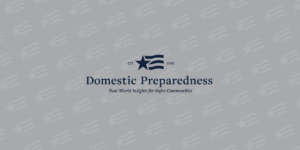
Hybrid Warfare – Merging Old & New Age Threats
Catherine L. Feinman
April 24, 2019
Since the end of the Second World War, nations around the globe have seen the evolution of
computers and the internet. The subsequent informational “melting pot” known as the World Wide Web has
created a fertile environment for sharing both critical intelligence and fictitious narratives. When
state actors leverage their existing conventional military tactics and combine them with ever-evolving
cyber technology, this new hybrid warfare tactic introduces numerous new and increasingly challenging
political, psychological, and economic threats.

MCMi Program Update – FY 2018
Domestic Preparedness
April 19, 2019
The United States Food and Drug Administration (FDA) plays a critical role in protecting the U.S. from chemical, biological, radiological, nuclear (CBRN), and emerging infectious disease threats such as pandemic

Uncharted Waters: Volunteers & Active Shooters
Andrew (Andy) Altizer and Barrett Cappetto
April 17, 2019
Universities often use volunteers to provide assistance in helping keep campuses safe and prepared. Most facilities on campus rely on volunteer crisis managers, crisis coordinators, fire wardens, or similarly named individuals to help with various emergency preparedness and response efforts – especially with evacuations. Some larger, or specialized facilities, have full-time building managers or engineers, who have emergency preparedness and limited response responsibilities. Additional volunteers can also fill such gaps with expanding roles and responsibilities.

Approach the Bench – Preparing Judges for Disasters & Emergencies
Andrew R. Roszak and Tina Batra Hershey
April 17, 2019
Underpinning any public health emergency response is a complex legal and regulatory framework. Understanding the interplay between the legislative, executive and judicial branches of government is key to ensure policies and actions are based on solid legal footing. This podcast examines the role of the judicial branch and explores how the Tribal Legal Preparedness Project at the University of Pittsburgh Center for Public Health Practice is working to enhance the legal preparedness of tribal nations. There are 573 federally recognized Indian tribes across 35 states in the United States. These tribal governments are sovereign entities and operate within their own authority to create and enforce their own laws, including those that would be used to respond to public health emergencies.

Harnessing Multilateral Financing for Health Security Preparedness
Domestic Preparedness
April 11, 2019
The economic consequences of large-scale disease outbreaks can be enormous. Upgrading countries’ preparedness is relatively inexpensive and affordable. The financing gap for preparedness is one of the starkest problems in health

Core Principles of Threat Management Units
Michael Breslin
April 10, 2019
Homeland security is a complex and ever-evolving challenge whose mitigation necessitates the actions and collaboration of personnel across all branches of government and the private sector. This enhanced complexity presents law enforcement, homeland safety, and security professionals with a myriad of challenges due to an environment overflowing with existential and hybrid threats, technological innovation, interconnectivity, and limited resources.transition done in the perceived safety of a child’s home under the supervision of his/her parent was and remains fraught with inherent danger.

Preparing for & Responding to Disaster – A 2018 Review
Christopher Reynolds and Allison Knox
April 3, 2019
Fire, wind, and water – a lot of water. The year 2018 delivered all in a series of natural disasters that seemed almost continual. Throughout the year, there was a






